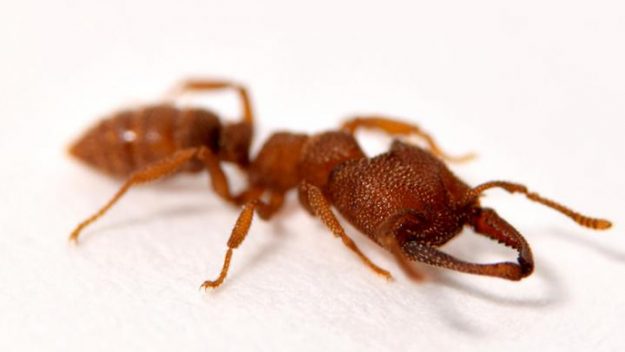The mandibles of of the ‘Dracula ant’, Mystrium camillae, are the fastest known moving animal appendages, snapping shut at speeds of up to to 90 meters per second.
According to a new study, the Dracula ant, Mystrium camillae, can snap its mandibles at speeds of up to 90 meters per second (more than 200 mph), making it the fastest animal movement on record.
The ants use this scary, high-impact motion, which is 5,000 times faster than a blink of an eye, to attack other arthropods, stunning them, smashing them against a tunnel wall or pushing them away, according to researchers, whose report was published in journal Royal Society Open Science. The poor prey is then transported back to the nest, where it is fed to the ants’ larvae.
“These ants are fascinating as their mandibles are very unusual,” said University of Illinois animal biology and entomology professor Andrew Suarez, who led the research with Fredrick J. Larabee, a postdoctoral researcher at the Smithsonian National Museum of Natural History; and Adrian A. Smith, of the North Carolina Museum of Natural Sciences and North Carolina State University, Raleigh. “Even among ants that power-amplify their jaws, the Dracula ants are unique: Instead of using three different parts for the spring, latch and lever arm, all three are combined in the mandible.”
Another kind of ant, the trap-jaw ant, also uses the mandibles in blink-or-you’ll-miss-it speed to capture or stun prey and to fight with other ants. But trap-jaw ants’ powerful jaws snap closed from an open position, while Dracula ants power up their mandibles by pressing the tips together, spring-loading them with internal stresses that release when one mandible slides across the other, similar to a human finger snap, the researchers said.
“Scientists have described many different spring-loading mechanisms in ants, but no one knew the relative speed of each of these mechanisms,” Larabee said. “We had to use incredibly fast cameras to see the whole movement. We also used X-ray imaging technology to be able to see their anatomy in three dimensions, to better understand how the movement works.”
From start to finish, the action takes 0.000015 seconds, going from zero to around 320 km/h (198 mph) in a fraction of an instant
The research team also conducted computer simulations of the mandible snaps of different castes of Dracula ants to test how the shape and structural characteristics of the mandibles affected the power of their snap.
“Our main findings are that snap-jaws are the fastest of the spring-loaded ant mouthparts, and the fastest currently known animal movement,” Larabee said.
This species of Dracula ants are mostly found in Australia, tropical Africa and Southeast Asia. They are rarely encountered as they live in large colonies underground, or inside tree trunks. Their name wasn’t derived from the wicked snap-jaw, but for from their extremely unusual feeding habits. They practice a sort of “non-destructive cannibalism,” chewing holes into and feeding on the haemolymph (insect “blood”) of the colony’s own pupae and larvae.








